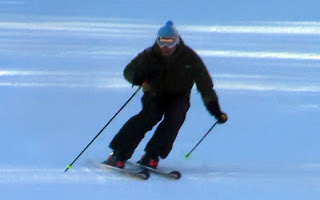When skiing we look ahead. Simple. But there is a little bit more to that statement. For where exactly do you look ahead? In short turns, it’s straight forward. Pick a point, actively look at it and keep heading towards it. (The technical definition of a short turn is one where the radius of the turn is within one cat track width. A cat is one of those huge machines that groom the snow each night and makes all that corduroy for our skiing pleasure the next day).
In tree skiing, you don’t look at the trees. You look to the gap between the trees that you intend to ski through. In the moguls, you start off by looking one bump ahead. As you get better, you’ll start to look two bumps ahead. One rarely looks at more than three bumps ahead. When you’re approaching a knoll or a drop off, guess what, keep looking at it till you can see what’s beyond. You’ll usually be doing short turns for all the above.
 Now in a longer turn, it’s a little different. You should actively be looking from transition to transition and from middle to middle.
Now in a longer turn, it’s a little different. You should actively be looking from transition to transition and from middle to middle.
When you initially start to focus on where you’re looking in skiing, it’s amazing how it can naturally and immediately reduce a lot of habitual body rotation. Your head, being attached to your shoulders, is looking more down the hill (instead of across) so your upper body tends to follow likewise.
Yet one of my pet hates is to hear an instructor (or wannabes) saying to someone that they should try to always face their shoulders down the hill when skiing.
Ski any turn wider than a short turn and our shoulder and upper body will inadvertently not be facing completely down the hill at some stage. We would probably twist our spines off if we kept trying. Similarly, a lot of those pole exercises where people hold them in front are again useless in any turn larger than a short turn.
So beyond just looking where our shoulders are facing or vice versa, when we change our line of sight in a longer turn, the neck and shoulders should operate independently.
 |
| Head and neck moves independently of shoulders and upper body. The upper body is also NOT ALWAYS facing down the hill in a longer turn. |
When we see where we want to be, our body is prepared and moves accordingly to be there. It’s very much like when we’re driving a car at speed. When we look ahead, we’re pre-empting the turn ahead subconsciously in our head and our body. We are relaxed and take the turn in our stride. The opposite is not looking very far ahead in a turn. It would be like driving in a fog where you can’t see much. You’re more tense and reacting to turns that suddenly come up on you.
turnshape.com. All Rights Reserved.





